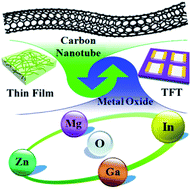High-mobility transparent amorphous metal oxide/nanostructure composite thin film transistors with enhanced-current paths for potential high-speed flexible electronics
Abstract
We review the improved performance of amorphous oxide semiconductor (AOS) based thin film transistors (TFTs) with embedded nanostructures. Amorphous indium zinc oxide/single-walled carbon nanotube (a-IZO/SWNT) composite TFTs exhibited a high mobility of 140 cm2 V−1 s−1 and robust flexibility comparable with those of organic TFTs. Obtaining the optimal device operation performance depends critically on the full control of mobility and threshold voltage (Vth). The Vth was readily tuned to a favourable value, and the device maintained a reasonably high mobility of 132 cm2 V−1 s−1. Moreover, the intrinsic cut-off frequency fT could reach 72 MHz. The amorphous indium zinc/In2O3 nanocrystalline (a-IZO/In2O3 NC) composite TFTs also demonstrated that the enhanced-current paths could generally improve the mobility of the AOS TFTs. The proposed strategy was reliable and reproducible for large-scale fabrication. The overall high performance indicated that amorphous metal oxide/nanostructure composite TFTs were readily suitable for large-scale low-power radio frequency applications.

- This article is part of the themed collection: Flexible Electronics

 Please wait while we load your content...
Please wait while we load your content...